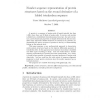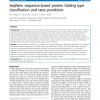122 search results - page 4 / 25 » Protein Fold Recognition using Residue-Based Alignments of S... |
BMCBI
2008
13 years 7 months ago
2008
Background: Recent approaches for predicting the three-dimensional (3D) structure of proteins such as de novo or fold recognition methods mostly rely on simplified energy potentia...
CORR
2006
Springer
13 years 7 months ago
2006
Springer
A protein is a sequence of amino-acids of length typically less than 1, 000, where there are 20 kinds of amino-acids. In nature, each protein is folded into a well-defined three-d...
RECOMB
2002
Springer
14 years 7 months ago
2002
Springer
A recent idea for determining the three-dimensional structure of a protein uses antibody recognition of surface structure and random peptide libraries to map antibody epitope comb...
BMCBI
2010
13 years 7 months ago
2010
Background: Protein folding rate is an important property of a protein. Predicting protein folding rate is useful for understanding protein folding process and guiding protein des...
JUCS
2010
13 years 6 months ago
2010
: When considering the prediction of a structural class for a protein as a classification problem, usually a classifier is based on a feature vector x ∈ Rn , where the features...


